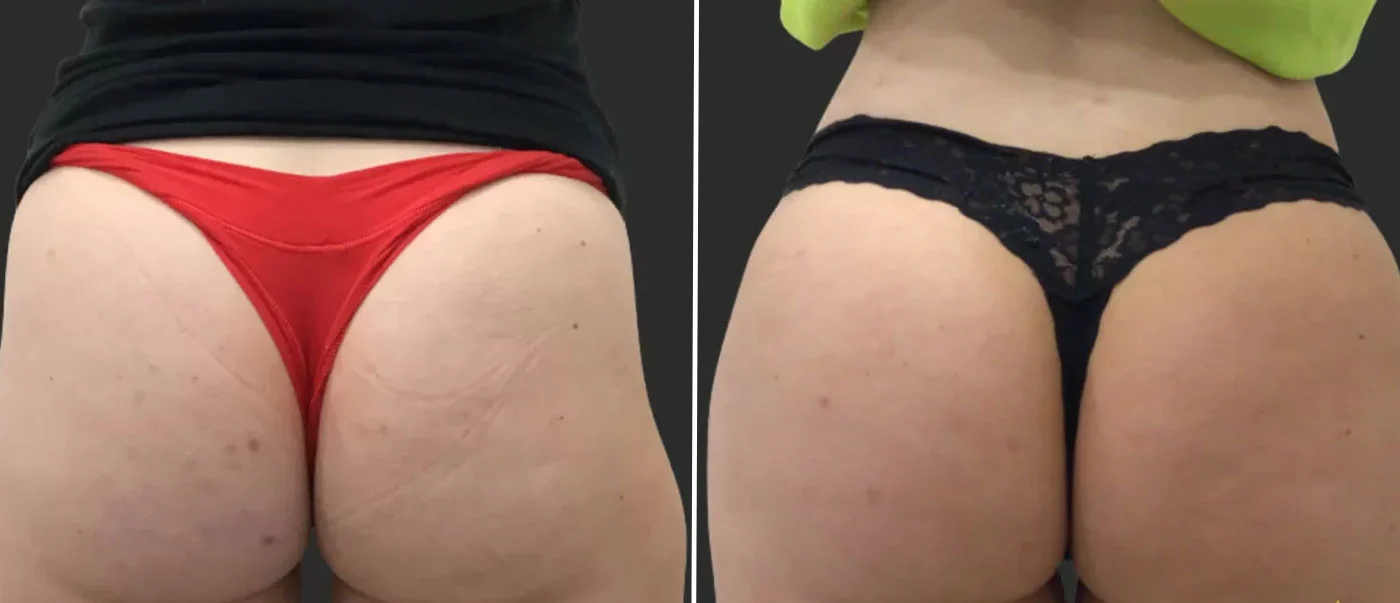
Butt fillers are temporary. Over time, the injected material gradually breaks down. This process does not happen overnight. Instead, the results fade slowly. The shape may become less lifted. Contours that once looked firm may soften. This transition can take several months. The rate depends on the filler type. Hyaluronic acid fades faster than longer-lasting materials. People may not notice the change immediately. Subtle shifts appear in photos first. Clothes may also fit differently. Some clients feel less confident during this period. Others accept the changes without stress.
Volume loss can cause asymmetry depending on how your body absorbs filler
Not all filler disappears evenly. One side may deflate faster than the other. This causes visible asymmetry. Fatigue or stress may exaggerate the look. Muscle tone also affects the outcome. If one side gets more daily use, filler breakdown can speed up there. Sitting habits influence pressure zones. Uneven pressure changes filler shape. Some people return to their injector when this happens. They seek correction. Others choose to let the process continue naturally. Either way, the imbalance is common.
The body will metabolize the material unless permanent fillers were used
If the filler is biodegradable, the body processes it. Enzymes break it down over time. The rate depends on your metabolism. Active lifestyles may accelerate absorption. Slower metabolisms prolong the results. Permanent fillers, however, stay in place. These do not break down naturally. They may form lumps or shift. Without maintenance, permanent fillers pose long-term risks. They often require surgical removal. Most patients today prefer temporary options. Temporary fillers offer flexibility. If you stop treatments, the effects will vanish naturally.
Skin may appear looser after filler fades, depending on original elasticity
When filler volume decreases, skin can sag. Especially if it was stretched before. The skin might not retract fully. This is more noticeable in thinner individuals. Age affects skin resilience as well. Younger patients recover skin tone faster. Those with strong collagen levels bounce back easily. Some people use firming treatments during this phase. Others consider radiofrequency sessions or ultrasound therapy. Skincare alone rarely resolves loose skin completely. If laxity bothers you, a plastic surgeon may advise surgery.
Sitting habits may feel different after losing volume in the gluteal area
People often underestimate how filler affects sitting. Once it fades, the sensation changes. Some describe it as less cushion-like. Others feel more direct pressure on bone. Those with sedentary jobs notice it more. Office chairs feel harder. Prolonged sitting causes discomfort. Cushions or ergonomic supports help. But nothing fully mimics filler support. Clients used to added volume feel the shift. Some begin seeking new filler treatments. Others adjust posture and seating choices.
Movement and posture might shift slightly when the butt loses artificial volume
Gluteal fillers subtly influence movement. They change balance, stance, and body mechanics. As fillers fade, the center of gravity shifts. Some report minor posture adjustments. These aren’t dramatic but noticeable. Athletes or dancers may feel more affected. Trainers sometimes detect movement differences. Weak muscles underneath the filler become apparent. Postural realignment or physical therapy may help. Regular exercise also strengthens supporting muscles. Once the volume disappears, the body adapts. But for a while, movement may feel unfamiliar.
Psychological adjustment is common after aesthetic volume begins to disappear
Cosmetic changes impact mental perception. Many grow attached to their enhanced shape. When the volume declines, emotions shift. Some feel disappointment or insecurity. Others accept it calmly. This depends on personal expectations. Social media influences perception too. Seeing others with maintained results can affect mood. Patients often return for consultation. They seek advice or reassurance. Emotional support helps during this period. It’s important to understand the temporary nature of fillers. Knowing this in advance reduces stress.
Some individuals experience mild rippling or uneven texture as filler dissolves
As fillers break down, texture changes. The surface may feel uneven. Light rippling can occur. This is more noticeable when bending or sitting. It does not affect everyone. Thin skin types show it more clearly. Massage may help distribute remaining filler. Hydration also supports skin integrity. In rare cases, uneven texture persists. Touch-up sessions address this. It’s usually a temporary issue. Once the filler fully absorbs, the skin smooths again.
No medical risk occurs with halting treatments, but outcomes depend on the material used
Stopping filler treatments is safe. There’s no medical obligation to continue. However, results fade naturally. If permanent fillers were used, stopping isn’t risk-free. These materials can cause reactions. Some shift under the skin or form granulomas. Temporary fillers don’t pose that issue. They disappear without causing harm. Discussing the type of filler with your provider matters. Knowing what was injected helps you predict changes. Always follow up with your practitioner if unsure.
Some clients opt for alternative treatments after stopping fillers altogether
Once they stop fillers, some try other options. Butt-lifting exercises gain popularity. Muscle-building regimens target glutes. Squats and lunges shape natural curves. Radiofrequency treatments help skin tightening. Others explore fat transfer surgery. This offers permanent results. It uses your own fat, unlike fillers. Some patients choose shapewear instead. It provides instant volume without procedures. The path depends on lifestyle, budget, and goals. There’s no single correct decision. The key is informed choice.
